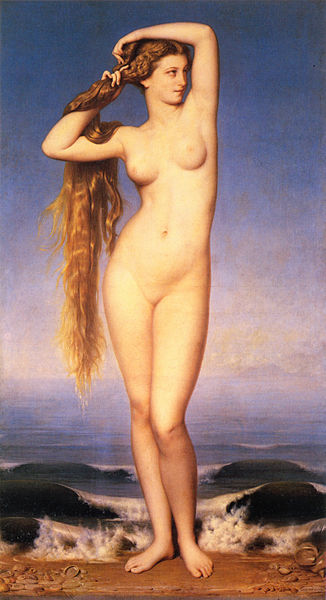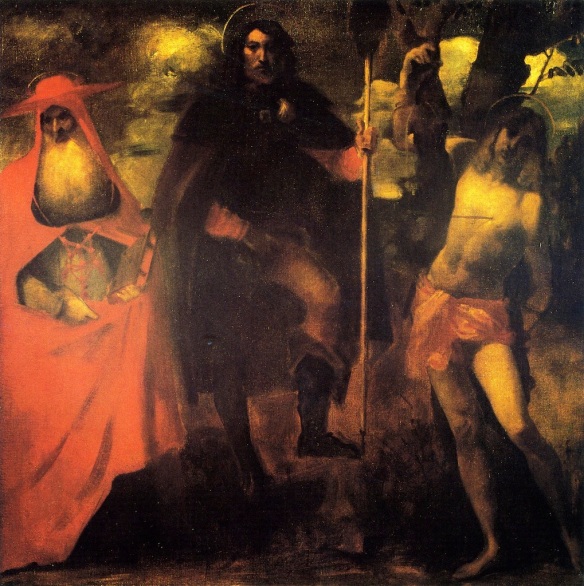 Primavera (also known as Allegory of Spring), Sandro Botticelli, c. 1482
Primavera (also known as Allegory of Spring), Sandro Botticelli, c. 1482
Most critics agree that the painting, depicting a group of mythological figures in a garden, is allegorical for the lush growth of Spring. Other meanings have also been explored. Among them, the work is sometimes cited as illustrating the ideal of Neoplatonic love. The painting itself carries no title and was first called La Primavera by the art historian Giorgio Vasari who saw it at Villa Castello, just outside Florence, in 1550.
The history of the painting is not certainly known, though it seems to have been commissioned by one of the Medici family. The painting overall was inspired by a description the Roman poet Ovid wrote of the arrival of Spring (Fasti, Book 5, May 2), though the specifics may have been derived from a poem by Angelo Poliziano. As Poliziano’s poem, “Rusticus”, was published in 1483 and the painting is generally held to have been completed around 1482, some scholars have argued that the influence was reversed.
Another inspiration for the painting seems to have been the Lucretius poem De rerum natura (On the Nature of Things), which includes the lines, “Spring-time and Venus come, and Venus’ boy, / The winged harbinger, steps on before, / And hard on Zephyr’s foot-prints Mother Flora, / Sprinkling the ways before them, filleth all / With colors and with odors excellent.”
Various interpretations of the figures have been set forth, but it is generally agreed that at least at one level the painting is, as characterized by Cunningham and Reich (2009), “an elaborate mythological allegory of the burgeoning fertility of the world.” Elena Capretti in Botticelli (2002) suggests that the typical interpretation is thus:
The reading of the picture is from right to left: Zephyrus, the biting wind of March, kidnaps and possesses the nymph Chloris, whom he later marries and transforms into a deity; she becomes the goddess of Spring, eternal bearer of life, and is scattering roses on the ground.
This is a tale from the fifth book of Ovid’s Fasti in which the wood nymph Chloris’s naked charms attracted the first wind of Spring, Zephyr. Zephyr pursued her and as she was ravished, flowers sprang from her mouth and she became transformed into Flora, goddess of flowers. In Ovid’s work the reader is told ’till then the earth had been but of one colour’. From Chloris’ name the colour may be guessed to have been green – the Greek word for green is khloros, the root of words like chlorophyll – and may be why Botticeli painted Zephyr in shades of bluish-green.
In addition to its overt meaning, the painting has been interpreted as an illustration of the ideal of Neoplatonic love popularized among the Medicis and their followers by Marsilio Ficino. The Neoplatonic philosophers saw Venus as ruling over both earthly and divine love and argued that she was the classical equivalent of the Virgin Mary; this is alluded to by the way she is framed in an altar-like setting that is similar to contemporary images of the Virgin Mary.
 Botticelli’s Pallas and the Centaur (1482) has been proposed as the companion piece to Primavera
Botticelli’s Pallas and the Centaur (1482) has been proposed as the companion piece to Primavera
In this interpretation, as set out in Sandro Botticelli, 1444/45-1510 (2000), the earthy carnal love represented by Zephyrus to the right is renounced by the central figure of the Graces, who has turned her back to the scene, unconcerned by the threat represented to her by Cupid. Her focus is on Mercury, who himself gazes beyond the canvas at what Deimling asserts hung as the companion piece to Primavera: Pallas and the Centaur, in which “love oriented towards knowledge” (embodied by Pallas Athena) proves triumphant over lust (symbolized by the centaur).
It is, on the other hand, possible that, rather than her having renounced carnal love, the intense emotional expression with which she gazes at Mercury is one of dawning love, proleptic of the receipt of Cupid’s arrow which appears to be aimed particularly at her; which emotion is being recognised with an expression both quizzical and apprehensive by the sister immediately to her left.
The origin of the painting is somewhat unclear. It may have been created in response to a request in 1477 of Lorenzo de’ Medici, or it may have been commissioned somewhat later by Lorenzo or his cousin Lorenzo di Pierfrancesco de’ Medici. One theory suggests Lorenzo commissioned the portrait to celebrate the birth of his nephew Giulio di Giuliano de’ Medici (who would one day become Pope), but changed his mind after the assassination of Giulo’s father, his brother Giuliano, having it instead completed as a wedding gift for Lorenzo di Pierfrancesco de’ Medici, who married in 1482.








































































